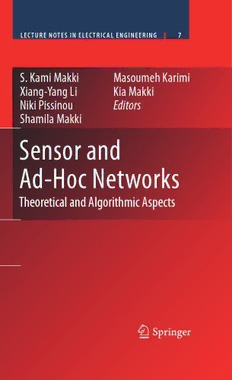Table Of ContentLECTURE NOTES IN ELECTRICAL ENGINEERING 7
S. Kami Makki Masoumeh Karimi
Xiang-Yang Li Kia Makki
Editors
Niki Pissinou
Shamila Makki
Sensor and
Ad-Hoc Networks
Theoretical and Algorithmic Aspects
1 23
Sensor and Ad Hoc Networks
LectureNotesinElectricalEngineering
Volume7
SensorandAdHocNetworks:TheoreticalandAlgorithmicAspects
S.KamiMakki,Xiang-YangLi,NikiPissinou,ShamilaMakki,MasoumehKarimi,andKiaMakki
ISBN978-0-387-77319-3,2008
CurrentTrendsinIntelligentSystemsandComputerEngineering
OscarCastillo,LiXu,andSio-IongAo
ISBN978-0-387-74934-1,2008
RecentAdvancesinIndustrialEngineeringandOperationsResearch
AlanH.S.Chan,andSio-IongAo
ISBN978-0-387-74903-7,2008
RecentAdvancesinCommunicationSystemsandElectricalEngineering
XuHuang,Yuh-ShyanChen,andSio-IongAo
ISBN978-0-387-74937-2,2008
Time-DomainBeamformingandBlindSourceSeparation
JulienBourgeois,andWolfgangMinker
ISBN978-0-387-68835-0,2007
DigitalNoiseMonitoringofDefectOrigin
TelmanAliev
ISBN978-0-387-71753-1,2007
Multi-CarrierSpreadSpectrum2007
SimonPlass,ArminDammann,StefanKaiser,andK.Fazel
ISBN978-1-4020-6128-8,2007
· · ·
S. Kami Makki Xiang-Yang Li Niki Pissinou
· ·
Shamila Makki Masoumeh Karimi Kia Makki
Editors
Sensor and Ad Hoc Networks
Theoretical and Algorithmic Aspects
12 3
Editors
S.KamiMakki Xiang-YangLi
UniversityofToledo IllinoisInstituteofTechnology
Toledo,OH Chicago,IL
USA USA
[email protected] [email protected]
NikiPissinou ShamilaMakki
FloridaInternationalUniversity FloridaInternationalUniversity
Miami,FL Miami,FL
USA USA
pissinou@fiu.edu shamila.makki@fiu.edu
MasoumehKarimi KiaMakki
FloridaInternationalUniversity FloridaInternationalUniversity
Miami,FL Miami,FL
USA USA
masoumeh.karimi@fiu.edu makkik@fiu.edu
ISSN:1876-1100
ISBN:978-0-387-77319-3 e-ISBN:978-0-387-77320-9
DOI:10.1007/978-0-387-77320-9
LibraryofCongressControlNumber:2007941257
(cid:2)c 2008SpringerScience+BusinessMedia,LLC
Allrightsreserved.Thisworkmaynotbetranslatedorcopiedinwholeorinpartwithoutthewritten
permission of the publisher (Springer Science+Business Media, LLC, 233 Spring Street, New York,
NY10013, USA),except forbrief excerpts inconnection with reviews orscholarly analysis. Usein
connection with any form of information storage and retrieval, electronic adaptation, computer
software,orbysimilarordissimilarmethodologynowknownorhereafterdevelopedisforbidden.
The use in this publication of trade names, trademarks, service marks, and similar terms, even if
they are not identified as such, is not to be taken as an expression of opinion as to whether or not
theyaresubjecttoproprietaryrights.
Printedonacid-freepaper
springer.com
Preface
Recentdevelopmentsinmobileandwirelesstechnologyalongwiththeavailability
of many smart and portable handheld devices facilitate the ubiquitous access to
information.However, many limitations exist in these devices and the underlying
networkduetolimiteddatatransmissioncapabilityofthesedevicesandtheevolv-
inganddynamictopologyofmobileandwirelessnetworks.Theflexiblestructure
ofsensorandadhocnetworkshasnotonlychangedtheformulationoftheexisting
problemssuchasdatacommunicationforthesenetworks,buthasalsoinvolvedthe
discoveryofnewsolutionsinanumberofotherareassuchasreliability,scalability,
energyefficiency,security,andinteroperability.Research iscurrentlyunderwayto
find solutionsand techniquesto address some of these issues such as the interop-
erabilityproblembetweensensorandadhocnetworkswhichusedifferentrouting
mechanisms,andtheadaptabilityproblemwhichoccursbetweenadhocandsensor
networksthatcouldverywellbeheterogeneouswithrespecttohardwarecharacter-
isticsandsoftwaresystems.Aself-adaptivesystemcanevaluatethebehaviorofthe
system and change it (e.g., configuration,algorithm, design, etc.) when the result
indicatesthatthesystemisnotaccomplishingwhatitwassupposedtodo,orwhen
theperformanceofthesystemdropsbelowacertainthreshold.Scalabilityisalsoan
importantissue forthesetypesofnetworks.Asthe applicationsofthese networks
forvarioustasks(e.g.,collectionofinformationinunfriendlyandinaccessibleter-
rains)suggest,thesizeofthesenetworkscangrowenormously.Thiscanreducethe
efficacyofalmostallfunctions(e.g.,routing,in-networkaggregation,etc.)required
bythesenetworks.Inaddition,mostexistingmathematicalmodelspredictthatthese
networkswillbecomeessentiallyincapableofoperatingeffectivelyiftheygrowex-
tremelylarge.Anotherchallengeistheissueofreliabilityforthesenetworks.This
issueiscomplexandhasmanyfacets,suchascoverage,routing,security,etc.The
lackoffixedinfrastructureandthemobilityalsomakesreliablenetworkoperation
verydifficult,ifnotimpossible.Thesecurityinthesenetworksmustalsobeinves-
tigated closely because of special characteristics and the usage of these networks
for many sensitive and important applications in medicine, e-commerce, and the
military.Themajorchallengeistosecurethesenetworksforexistingandfuturevul-
nerabilities,althoughbuildingaperfectsecuresystemisalwaysdifficult.Thelack
ofstaticinfrastructureofthesenetworksmultipliesthesecurityissuesathand,such
as nodeauthenticationand secure routing.Furthermore,the ad hoc configurations
v
vi Preface
ofthesenetworksincreasethecomplexityofdetectionandpreventionofattacksby
anorderofmagnitude.
Therefore, there are many fundamentalopen questions in various areas related
toadhocandsensornetworks.Theseneedtobeansweredandinvestigatedbefore
ubiquitousaccess becomesa fully workableand available technology.The aim of
thisbookistoidentifytheareasthatareinneedofspecialattentionandpresenta
numberof research findings,which correspondto noteworthycontributionsin the
areas of algorithmic aspects of sensor and ad hoc networksfor currentand future
sensorandadhocnetworks.Itisourhopethatthediversealgorithmsandprotocols
describedinthisbookwillgivereadersagoodideaofthecurrentstateoftheartin
mobileandwirelesstechnology.Theauthorsofeachchapterareamongtheleading
researchersorpractitionersinthefield.
S.KamiMakki
Xiang-YangLi
KiaMakki
NikiPissinou
ShamilaMakki
MasoumehKarimi
Acknowledgement
This book would not have been possible without the wisdom and collaboration
of the contributing authors. Special thanks to the personnel at the University of
Toledo,FloridaInternationalUniversity,IEEEMiamisection,andNationalScience
Foundation∗forprovidinguswithastimulatingenvironmentforwritingthisbook.
WewouldalsoliketothankAlexGreene,seniorPublisherandhisstaff,specif-
icallyKatelynStanneatSpringerScience &Business fortheirstrongsupportand
encouragements.It was a pleasure working with Alex and Katelyn, who were in-
crediblypatient,veryresponsible,andenthusiasticaboutthisbook.Wealsowould
liketoexpressoursincereappreciationtothereviewersofthisbook,whosesugges-
tionswereinvaluable.
This book would not have been possible without the indulgence and infinite
patience of our families during what often appeared to be an overwhelmingtask.
Theygraciouslyaccommodatedthelosttimeduringevenings,weekends,andvaca-
tions.Asasmallmeasureofourappreciation,wededicatethisbooktothem.
∗This material is based upon work supported by the National Science Foundation under Grant
No.0437586.Anyopinions,findings,andconclusionsorrecommendationsexpressedinthisma-
terialarethoseoftheauthor(s) anddonotnecessarily reflect theviewsoftheNationalScience
Foundation.
vii
Contents
1 Establishing New Research Initiatives for Theoretical
and AlgorithmicAspectsofSensorandAdHocNetworks .......... 1
S.KamiMakki,AbdelmounaamRezgui,WuxuPeng,KiaMakki,
Chung-HorngLung,NikiPissinou,ShamilaMakki,
MasoumehKarimi,andMohamedEltowiessy
2 RandomGraphModelsandtheLimitsofScalabilityinAdHoc
andSensorNetworks ........................................... 19
Andra´sFarago´
3 Analysis of Effective Connectivity in Mobile Wireless
Communications ............................................... 43
J.DavidHaughsandDongsooS.Kim
4 SomeDetectabilityIssuesinSensorNetworks ..................... 73
WuxuPeng,XindeJiaandEricReeves
5 Comparative Methods of Channel Assignment in Multivariate
WirelessNetworks .............................................101
XufeiMao,Xiang-YangLi,andS.KamiMakki
6 Heterogeneous Wireless Networks: QoS-Aware Integration
Architecture...................................................123
AshrafNusairat,Xiang-YangLi,andS.KamiMakki
7 Distributed Energy-Aware Topology Control Algorithm
forWirelessSensorNetworks....................................147
ZijianWangandJunZhang
8 MFACE:AMulticastBackbone-AssistedFaceTraversalAlgorithm
forArbitraryPlanarAdHocandSensorNetworkTopologies .......161
HannesFreyandFranc¸oisIngelrest
ix
x Contents
9 Service-DrivenQueryRoutingin Sensor-ActuatorNetworks .......181
AbdelmounaamRezguiandMohamedEltowiessy
10 Multiscale Anchor-Free Distributed Positioning
inSensorNetworks.............................................203
BastianKatzandDorotheaWagner
11 Evaluation of Time Synchronization over Mobile
AdhocNetworks...............................................221
XiweiZhao,VinayakGanapathy,NikiPissinou,andKiaMakki
12 UniversalModularFrameworkforSensorNetworks...............237
EliDePoorter,BenoˆıtLatre´,IngridMoerman,andPietDemeester
13 Application and Evaluation of Hierarchical Agglomerative
ClusteringinWirelessSensorNetworks ..........................255
ChenjuanZhouandChung-HorngLung
14 AFault-TolerantSchemeforDetectionofDDoSAttackPatterns
inCluster-BasedWirelessSensorNetworks .......................277
ZubairA.BaigandAsadI.Khan
15 Forming Energy-Efficient Bluetooth Scatternets
forSensorNetworks............................................297
SainSaginbekov
Index .............................................................307

